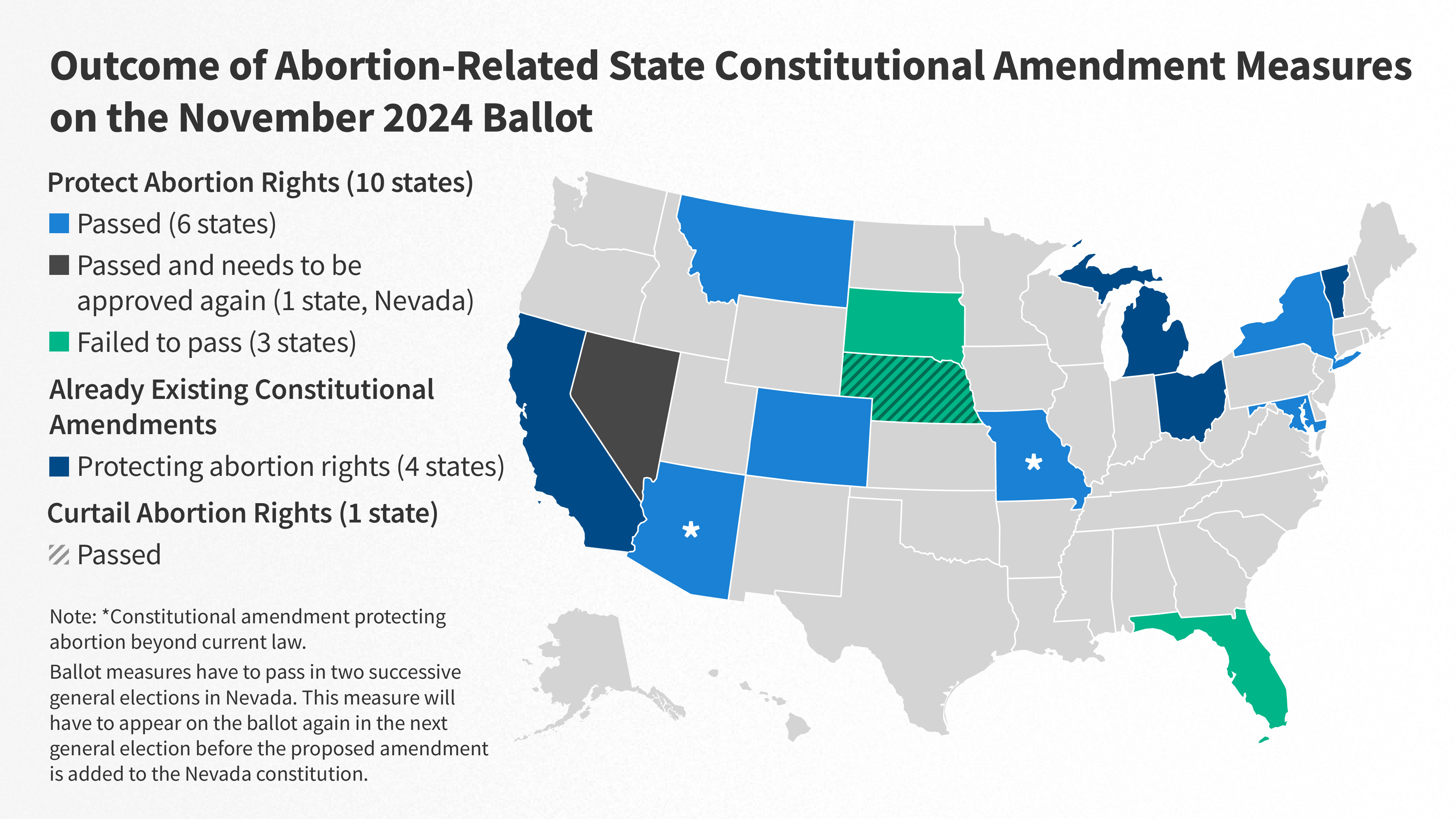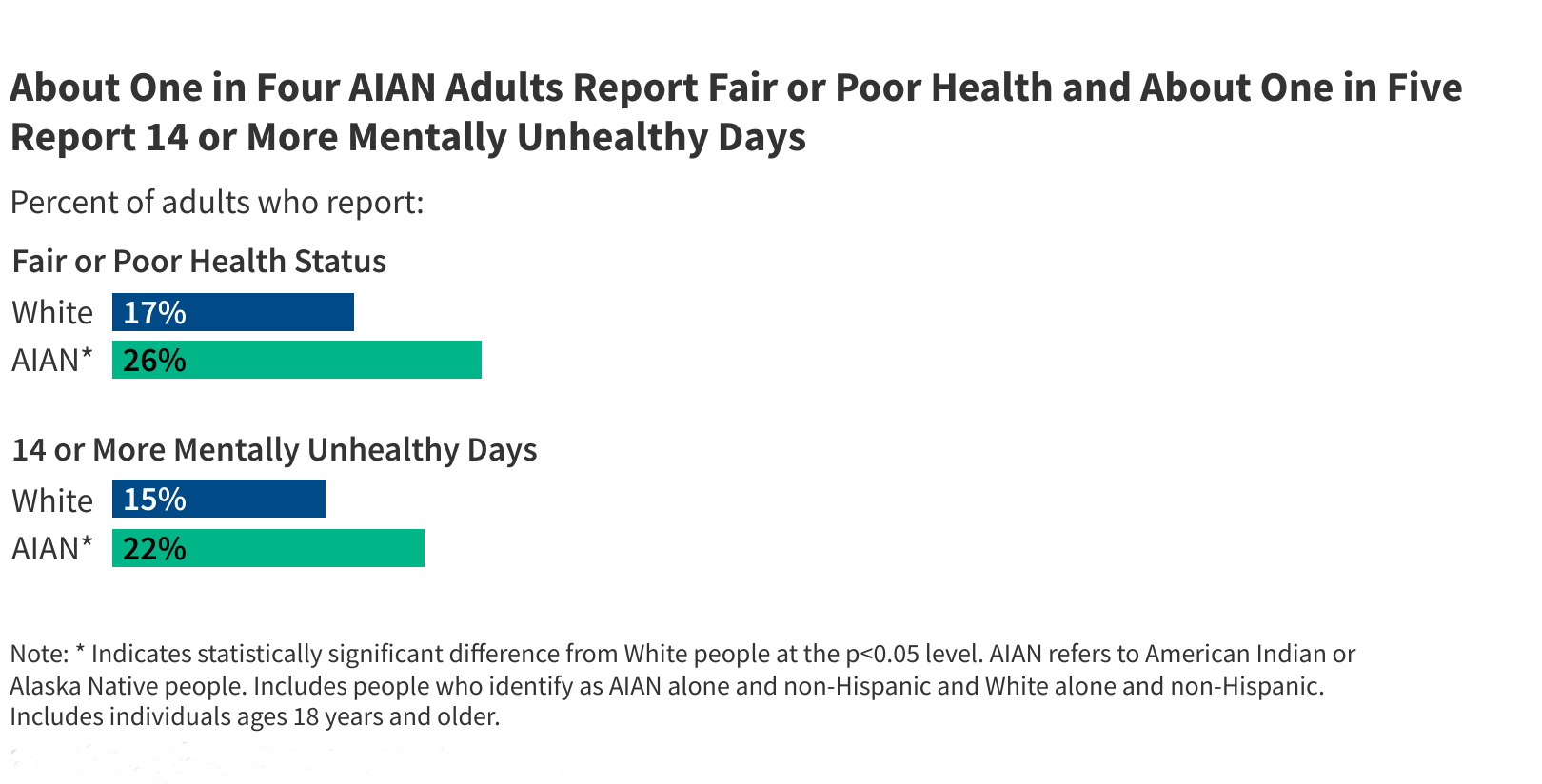Since the Supreme Court overturned Roe v Wade in June 2022, states have been able to set policy that defines abortion access across this nation. State actions have ranged from those that have effectively banned all abortions unless the pregnancy presents an imminent life threat to states that have enshrined the right to abortion in their state constitutions. This past November, voters in 10 states weighed in on constitutional amendment ballot measures to protect abortion rights.
The states that recently approved constitutional amendments protecting abortion rights in November (Arizona, Colorado, Maryland, Missouri, Montana, and New York) now join the states—California, Michigan, Ohio, and Vermont—that already had recently added these protections to their state constitutions (Figure 1). However, in Florida, Nebraska, and South Dakota, the abortion rights amendments failed to garner sufficient votes for passage. In Nebraska, voters approved a competing measure to ban abortion after the first trimester. Nevada voters approved their state amendment but will need to weigh in again in the general election in 2026, as the state rules require constitutional amendments to pass in two general elections. This brief examines what the November election and prior efforts to enshrine abortion rights at the ballot box mean for those states and what’s next, including the future of abortion restrictions in states where voters enshrined abortion rights where abortion was banned or restricted, as well as those that do not have abortion bans.
Going forward, if law makers seek to restrict abortion in the states with new constitutional amendments protecting abortion rights, state courts will evaluate any abortion restrictions under the new amendment. Protections from restrictions beyond pre-viability bans will vary from state to state based on the language in their constitutional amendment and how their highest court interprets the language. After this general election, there are only two more states with abortion bans that allow citizens to propose new constitutional amendments and have not already attempted to do so.
What will be the fate of abortion restrictions?
Of the seven states that passed amendments protecting abortion rights, two (Arizona and Missouri) had pre-viability abortion bans. In these states, advocates have filed legal challenges to their abortion limits, alleging that they violate the newly established amendments. While the litigation in Arizona proceeds, the 15-week ban is not in effect and clinics are providing abortion care beyond this gestational limit.
The new constitutional amendments offer protections that prevent the state from burdening or interfering with someone’s right to abortion. This means that these constitutional amendments protecting a right to abortion may be used to do more than just challenge pre-viability gestational limits and may also be used to take on other abortion restrictions such as waiting periods, telehealth abortion restrictions, and physician only requirements. Additionally, because some of these constitutional protections go beyond the federal protections that existed under Roe and Casey, abortion restrictions such as waiting periods and the exclusion of abortion coverage in Medicaid programs, may be struck down by state courts.
This has already begun to happen in Michigan and Ohio where abortion rights advocates have challenged abortion restrictions on the basis that they violate their respective reproductive freedom amendments passed by voters in prior elections. Courts in Ohio have already blocked state laws prohibiting advanced practice clinicians from providing medication abortion, requiring in-person counseling, and a 24- hour waiting period after the counselling. Similarly, courts in Michigan have blocked laws limiting the provision of abortion to physicians and requiring a 24-hour waiting period. Michigan advocates have additionally asked a state court to rule that the ban on state funding of abortions for Medicaid enrollees is unconstitutional based on the amendment approved by Michigan voters.
Whether or not similar restrictions that have been in force in these states prior to the election (Table 1) will be blocked in Arizona and Missouri will depend on the wording of their respective abortion-related constitutional amendments and how state courts interpret these protections. While the removal of some of these restrictions is up to judicial interpretation, the Colorado ballot measure directly prevents the state from prohibiting health insurance coverage of abortion and repealed a section of the Colorado Constitution that explicitly prohibited the use of state funds to pay for abortion care, except when necessary to safeguard the life of the pregnant person. The passage of the Colorado measure removes these restrictions on state funds, which had previously prevented the state from using its own funds to provide coverage of abortion care for their Medicaid enrollees in circumstances other than the restrictions on federal funding outlined in the Hyde amendment—previously only allowing the state to cover abortions in cases of life endangerment and rape or incest. Other states, like Arizona and Missouri similarly restrict the use of state funds to provide coverage of abortion services for Medicaid recipients.
Citing the newly passed constitutional amendment, advocates in Missouri have filed a lawsuit challenging the state’s abortion ban and many restrictions. They argue the abortion ban and restrictions, including a 72-hour waiting period, telemedicine ban, and physician only provision, impermissibly interfere with the right to reproductive freedom the Missouri constitution now protects. The language in the state’s new constitutional amendment prevents the state from denying, interfering with, delaying, or otherwise restricting the right to reproductive freedom unless the government can demonstrate that the restriction has the “effect of improving or maintaining the health of a person seeking care, is consistent with widely accepted clinical standards of practice and evidence-based medicine, and does not infringe on that person’s autonomous decision-making.” This is a high bar for the state to clear if anti-abortion advocates are seeking a path to apply limited restrictions, though the Missouri Supreme Court will be the final arbiter of which restrictions will be allowed to stand.
How will the abortion initiatives affect the states that did not have abortion bans?
While five of the states that approved citizen initiatives to enshrine abortion rights in November 2024 do not have abortion bans, these state constitutional amendments provide assurance that abortion rights will be protected in the future. Regardless of how the political winds may change in a state, a constitutional amendment explicitly enshrining abortion rights will mean that lawmakers and even judges cannot enact or interpret the laws to limit abortion access, even if the composition of the state’s high court changes or the state government moves in a different direction. These constitutional protections can only be undone by a subsequent initiative that amends the state’s constitution.
Looking to the future
After the November 2024 election, there are two states (Arkansas and Oklahoma) with current bans which allow for a citizen initiated constitutional amendments and have yet to vote on an abortion measure (Figure 2). There were efforts in Arkansas (where there is a near total abortion ban) to get an initiative on the ballot, but the Arkansas Secretary of State rejected the petition for the initiative on the grounds that the signatures were not properly gathered and thus did not make it to the ballot. The Arkansas Supreme Court upheld this decision. In Florida, there is a 6-week LMP abortion ban, but the 2024 initiative failed to garner the needed 60% approval needed for passage. It is unknown whether abortion rights supporters will try again to gain approval in a future election given that the popular vote fell just 3 percentage points short of approval in the last election.
It is also unclear if anti-abortion proponents will propose new ballot initiatives to remove the new constitutional amendments protecting the right to abortion in Missouri and Arizona. Thirteen states with abortion bans or earlier gestational limits do not have a citizen initiative process to amend their constitutions. These states will likely continue to have those laws on the books, unless a new federal law guaranteeing abortion rights is passed by Congress and signed by the president or a future Supreme Court ruling overturns the 2022 Dobbs decision.
Publisher: Source link










